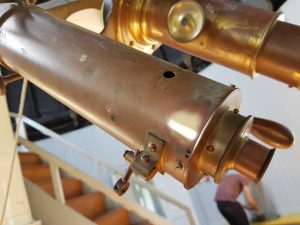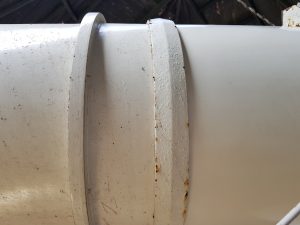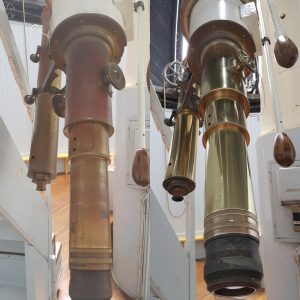By Gabriel Finneran
As the fourth week of our internship began to draw to a close, we arrived at Dunsink early Friday morning to begin cleaning the South Dome Refractor. Light flooded the room as Tess pulled open the dome, throwing golden sunshine across the room and revealing the long journey that lay ahead of us. It being a wonderful day we were happy to get stuck in and with the sun pouring in we set to work. We decided to focus on the telescope body, dusting it with brand new cloths that quickly turned black as they soaked up decades of dirt. In parts the dust was so ingrained that our pace slowed considerably.
morning to begin cleaning the South Dome Refractor. Light flooded the room as Tess pulled open the dome, throwing golden sunshine across the room and revealing the long journey that lay ahead of us. It being a wonderful day we were happy to get stuck in and with the sun pouring in we set to work. We decided to focus on the telescope body, dusting it with brand new cloths that quickly turned black as they soaked up decades of dirt. In parts the dust was so ingrained that our pace slowed considerably.
We gradually worked our way up the telescope, with dust beginning to fill the air and twinkle in the sunlight, we knew we were getting clo se and soon the telescope glimmered so intensely that it was difficult to keep my eyes on it. Meanwhile, Oscar focused on removing the detritus littering the floor and the windowsills (think dead flies and spiders!). Having cleaned the telescope as be st we could I decided to tackle the daunting task of restoring the brass eyepieces to their former glory. I managed to reveal a tiny spot before we stopped for lunch, but the signs were promising.Â
se and soon the telescope glimmered so intensely that it was difficult to keep my eyes on it. Meanwhile, Oscar focused on removing the detritus littering the floor and the windowsills (think dead flies and spiders!). Having cleaned the telescope as be st we could I decided to tackle the daunting task of restoring the brass eyepieces to their former glory. I managed to reveal a tiny spot before we stopped for lunch, but the signs were promising.Â
We returned on Tuesday, armed with toothbrushes to speed up the process. We met resistance at first and felt that we may have bitten off more than we could chew, but finally, chinks of metallic yellow-gold surfaced, glimmering brilliantly in the sunlight. Spurred on we charged ahead, wearing away the tarnished brass with healthy lashings of Brasso. Oscar and Tess tackled the viewfinder whilst I worked on the main eyepiece. Eventually we connected larger areas and tackled the tricky knobs and corners which Grubb had placed in our way. We settled into the rhythm of cleaning and polishing. After about two hours of non-stop scrubbing and with our arms getting tired, I noticed number s peering up at me from
s peering up at me from  the now gleaming brass. Further exploration with my toothbrush revealed notches spaced evenly around the barrel. What could these possibly be? We had many theories from measurement aids to alignment to magnification. It was a delight to discover something not seen for many decades and to ensure that it will be protected from now on.
the now gleaming brass. Further exploration with my toothbrush revealed notches spaced evenly around the barrel. What could these possibly be? We had many theories from measurement aids to alignment to magnification. It was a delight to discover something not seen for many decades and to ensure that it will be protected from now on.
When Peter arrived to survey our work, his jaw dropped. He couldn’t believe how dazzlingly bright the telescope was. Oscar and Tess decided to set up the clock drive, which allows the telescope to track with the Earth’s rotation as stars move across the sky. A large weight powers the mechanism which slowly rotates the telescope. Within minutes it was quietly whirling away, it was fabulous to see this 172-year-old equipment still working so well. We closed the dome, shut off the lights and turned back to peer into the darkness at our handiwork. There was a lot more light shining back at us than when we arrived on Friday!
Leave a Comment
Last Updated: July 22, 2019 by Gabriel Finneran
#5 Brasso and Bling
By Gabriel Finneran
As the fourth week of our internship began to draw to a close, we arrived at Dunsink early Friday morning to begin cleaning the South Dome Refractor. Light flooded the room as Tess pulled open the dome, throwing golden sunshine across the room and revealing the long journey that lay ahead of us. It being a wonderful day we were happy to get stuck in and with the sun pouring in we set to work. We decided to focus on the telescope body, dusting it with brand new cloths that quickly turned black as they soaked up decades of dirt. In parts the dust was so ingrained that our pace slowed considerably.
morning to begin cleaning the South Dome Refractor. Light flooded the room as Tess pulled open the dome, throwing golden sunshine across the room and revealing the long journey that lay ahead of us. It being a wonderful day we were happy to get stuck in and with the sun pouring in we set to work. We decided to focus on the telescope body, dusting it with brand new cloths that quickly turned black as they soaked up decades of dirt. In parts the dust was so ingrained that our pace slowed considerably.
We gradually worked our way up the telescope, with dust beginning to fill the air and twinkle in the sunlight, we knew we were getting clo se and soon the telescope glimmered so intensely that it was difficult to keep my eyes on it. Meanwhile, Oscar focused on removing the detritus littering the floor and the windowsills (think dead flies and spiders!). Having cleaned the telescope as be st we could I decided to tackle the daunting task of restoring the brass eyepieces to their former glory. I managed to reveal a tiny spot before we stopped for lunch, but the signs were promising.Â
se and soon the telescope glimmered so intensely that it was difficult to keep my eyes on it. Meanwhile, Oscar focused on removing the detritus littering the floor and the windowsills (think dead flies and spiders!). Having cleaned the telescope as be st we could I decided to tackle the daunting task of restoring the brass eyepieces to their former glory. I managed to reveal a tiny spot before we stopped for lunch, but the signs were promising.Â
We returned on Tuesday, armed with toothbrushes to speed up the process. We met resistance at first and felt that we may have bitten off more than we could chew, but finally, chinks of metallic yellow-gold surfaced, glimmering brilliantly in the sunlight. Spurred on we charged ahead, wearing away the tarnished brass with healthy lashings of Brasso. Oscar and Tess tackled the viewfinder whilst I worked on the main eyepiece. Eventually we connected larger areas and tackled the tricky knobs and corners which Grubb had placed in our way. We settled into the rhythm of cleaning and polishing. After about two hours of non-stop scrubbing and with our arms getting tired, I noticed number s peering up at me from
s peering up at me from  the now gleaming brass. Further exploration with my toothbrush revealed notches spaced evenly around the barrel. What could these possibly be? We had many theories from measurement aids to alignment to magnification. It was a delight to discover something not seen for many decades and to ensure that it will be protected from now on.
the now gleaming brass. Further exploration with my toothbrush revealed notches spaced evenly around the barrel. What could these possibly be? We had many theories from measurement aids to alignment to magnification. It was a delight to discover something not seen for many decades and to ensure that it will be protected from now on.
When Peter arrived to survey our work, his jaw dropped. He couldn’t believe how dazzlingly bright the telescope was. Oscar and Tess decided to set up the clock drive, which allows the telescope to track with the Earth’s rotation as stars move across the sky. A large weight powers the mechanism which slowly rotates the telescope. Within minutes it was quietly whirling away, it was fabulous to see this 172-year-old equipment still working so well. We closed the dome, shut off the lights and turned back to peer into the darkness at our handiwork. There was a lot more light shining back at us than when we arrived on Friday!
Category: Blog Posts, Events
Latest News
Read all about the new Astronomical Observatories of Ireland partnership here.
Latest Blog Post
Read about our new STEAM project Space Crafts here!
Events
Check out our upcoming events at dunsink.dias.ie/events.
Follow Us